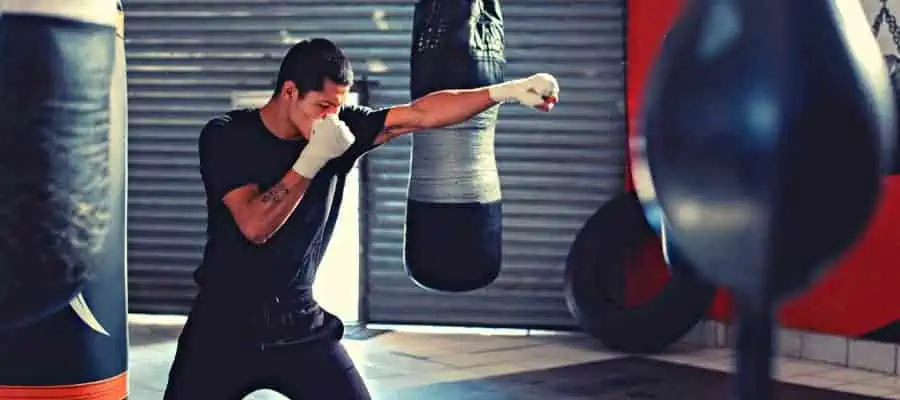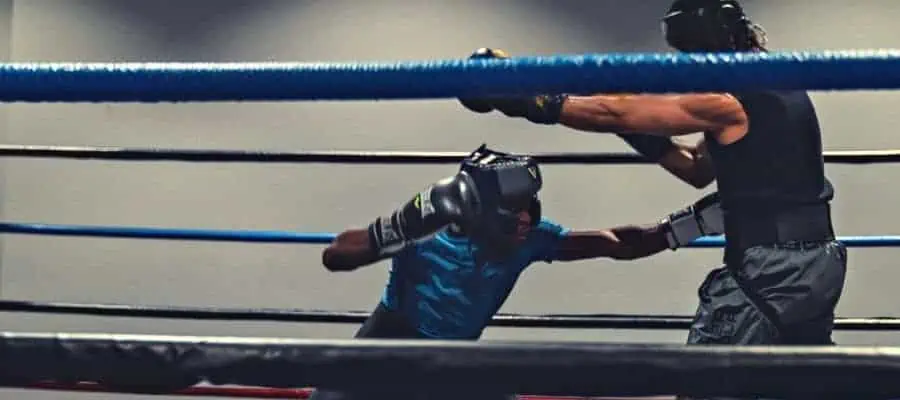In boxing, one of the most important defensive techniques is learning how to block or avoid getting hit by a hook. A well-executed hook can knock an opponent out, so it’s important to know how to defend against it. So how do you exactly block a hook? Should you avoid it altogether?
There are two main ways to defend against a hook in boxing. The first is to block the punch with your gloves and forearm. The second way to defend against a hook is to avoid getting hit by it altogether. This can be done by moving your head out of the way of the punch or by ducking under it.
You can even counter the hook. If you find yourself in a situation where you are being attacked with a hook, there are a few things that you can do to counter it. One is to throw a jab at your opponent’s face to distract them and break their focus. Another is to throw a hook of your own. A well-placed counter hook can knock out your opponent. Finally, if you are close enough, you can grab onto your opponent and clinch with them.
Which Type Of Hook Are You Blocking?

In boxing, there is the lead hook and the back hook. They are different in a few different ways, but they are both still hooks. If you are in an orthodox stance, then your lead hook is thrown with your left hand. The lead hook is when you throw a left hook to the head of your opponent if you are right-handed and vice versa if you are left-handed.
A back hook is when you throw a hook with your right hand. The back hook is quite often more powerful. The back hook is more damaging since it is thrown with the fighter’s dominant hand. However, the lead hook can be as dangerous as the back hook.
The lead hook can be quite unpredictable and very fast if thrown well. The lead hook can also be thrown into a quite vulnerable area of the body. We are, of course, talking about the liver. If the lead hook connects with your liver, you will be in a world of pain.
So, there are different defense options for each type of hook.
Blocking A Hook To The Head

When blocking a hook, always keep your chin tucked down and to the side. This will protect you from getting hit in the jaw, which is one of the most vulnerable parts of your head.
To block a hook with your gloves, hold your gloves connected to your face. If a hook is coming for your face, make sure to lift your elbows to cover your head. If you have enough time to react, you can even slide your hand to the back of your head. By sliding the hand to the back of your head, you will provide a bigger surface of protection against the hook.
Make sure to be in a stable stance when blocking the hook. If you are not stable, there is a chance the hook could throw you off balance. And if you are off-balance, your opponent has an added chance to score a hit on you.
Blocking A Hook To The Body

The best way to block a hook to the body is to lower your blocking arm slightly. By blocking arm, we mean the arm which will be used for blocking the hook. So if you are blocking a lead hook, then you will use your right arm. If you are blocking a back hook, then you will be using your left arm.
After you lower your blocking arm, make sure that your glove is still connected to your chin. You do not want to leave your chin exposed in any circumstance. By lowering your blocking arm and keeping your glove close to your chin, you will be protecting your whole upper body.
Your opponent might try to surprise you by throwing a hook to the body after they have thrown a few hooks to the head. If this happens, you need to be prepared. The best way to defend against a body shot is by using your front arm. So if you are right-handed, then use your left arm to block the punch.
And if you are left-handed, use your right arm to block the punch. You can also lean back when defending against a body shot. This will help you avoid getting hit in the solar plexus, which can be very painful and knock the wind out of you.
Your opponent might also try to throw a hook to the head after throwing a few hooks to the body. That is why you have to have your guard up always. Having your gloves touching your chin all the time is super necessary.
Another thing we would recommend when blocking a hook to the body is to breathe out. At the moment your opponent’s hook connects with your body, breathe out slightly. This will help you not get the wind knocked out of you.
Slipping A Hook

Slipping a hook can help you avoid taking any damage from the punch. It is an essential skill to learn in boxing and should not be ignored by beginner fighters.
There are several ways that you can slip a hook, but the most common one involves using your shoulders to block or deflect it. To do this, move your head out of the way at the same time as raising your shoulders so that they partially cover your face. This will lessen the impact of the punch and allow you to get out of its way without too much trouble.
Another way to slip a hook is by ducking under it. This can be done by dipping your head down at the same time as the punch is thrown so that it goes over your head instead of hitting you in the face. Be careful to duck under the punch with your legs and not your upper body.
What we mean by this is that you should make a small but fast squat move under your opponent’s hook. This is a much faster and more efficient way of dodging the hook. If, for example, you tried to dodge the hook by moving your upper body, you wouldn’t be fast enough.
First of all, it would be much more difficult to dodge the hook by moving your upper body. It would also use more of your energy. And lastly, it would throw you off balance. And we all know that being off-balance is never a good thing in boxing.
Once you have slipped a punch, it is important to counter-attack immediately. If you wait too long, then your opponent may be able to recover and launch another attack. So, as soon as you have slipped their hook, throw a punch of your own and take them by surprise.
Avoiding The Hook Altogether

If your opponent is not close enough, you might be able to jump away from their hook. If you see your opponent preparing for a hook, be ready to move backward or to the side. This will keep you from taking damage from the hook and make it harder for your opponent to hit you.
Additionally, boxing techniques like bobbing and weaving can help you avoid getting hit by a hook. With some practice and proper footwork, you can avoid being hit by hooks and stay in the fight longer. So if you’re facing an opponent who loves to throw hooks, don’t be afraid to get creative and use these strategies to outmaneuver them!
How To Practice Your Hook Defense?

Shadowboxing is a great way to practice blocking a hook. By throwing punches in the air, you can get a feel for how to block a hook with your arms. Be sure to keep your elbows close to your body and tuck your chin down to protect your head. Shadowboxing can also help you work on your footwork and movement, which are important factors in blocking a hook.
If you are training with a partner, you can also practice blocking hooks. Try avoiding and blocking your partner’s punches. This will help you get a feel for how to avoid getting hit by a hook, as well as how to land one yourself. You can also pair up with someone who is more experienced to receive feedback on your technique and performance.
Sparring is also a great way to practice blocking a hook. In sparring, you will be up against an opponent who is throwing punches at you. This can be a great way to get used to the speed and power of hooks, as well as how to properly block them. Be sure to wear all the proper safety gear, such as gloves, headgear, and a mouthguard.
Ducking under a rope or other tie-down is also an excellent way to practice blocking hooks. These items can help you focus on your movement and footwork, which are essential skills when it comes to successfully blocking a hook. Make sure that the rope or tie-down is secured properly so that you don’t fall and hurt yourself while practicing.
Southpaw Drills
If you’re a southpaw, the hook punch can be one of the most difficult punches to avoid. If you don’t have the proper techniques down, your opponent will be able to hit you with this powerful punch over and over again.
That’s why it’s important to learn the best drills for avoiding the hook punch. With these drills, you’ll be able to develop the reflexes and skills needed to avoid this punch and keep your opponents guessing.
The first drill is called the “parry and weave.” To do this drill, you’ll need a partner. Have your partner stand in front of you in a southpaw stance and throw a series of hook punches at your head.
As each hook comes in, you’ll need to parry the incoming punch with your lead glove. Then, use a quick weave outwards to avoid the follow-up hook. As you do this drill over and over again, you’ll develop better reflexes and timing when it comes to avoiding this punch. This will help keep you safe in future fights and competitions.
Another great drill for avoiding the hook punch is called the “step back.” To do this drill, stand facing a partner who is throwing hook punches at your head from close range. As each punch comes in, take a single step back while keeping your hands up high.
This will force your opponent to throw their hooks slightly off-balance, which increases their chances of missing. If you take this drill slower at first, then gradually increase your speed as you get better. You’ll improve your defensive skills soon enough.
Counter Punches
When facing a hook punch, one of the most important things to remember is to have a good counterpunch ready. A well-timed and well-placed counterpunch can help you block your opponent’s attack and possibly even knock them out.
There are many different types of counter punches that can work against a hook punch, including jabs, crosses, uppercuts, and overhands. Each type has its strengths and weaknesses, so it’s important to choose the right counter for your particular situation.
Some tips for using a boxing counter punch effectively against a hook include staying light on your feet and moving quickly out of range when necessary. You should also keep your hands up at all times and focus on timing your counter punch for when your opponent’s attack is at its weakest.
Conclusion
When boxing, it is important to know how to counter after a hook. There are several different strategies that you can use to do this effectively. This includes quickly stepping out of range or using the power of your upper body to keep yourself protected. Using your leg strength to slip under a hook is another great tool.
Utilizing defensive moves like bobbing and weaving can also be of great significance. Additionally, having good footwork and being able to read your opponent’s movements will also help you stay safe during a boxing match. With these tips in mind, you can effectively defend yourself when facing a hook and continue with your boxing training or match with confidence.
Recent Posts
What is Manachai's Fighting Style? Unveiling Muay Thai Mastery
Manachai, a celebrated figure in the Muay Thai world, has captivated audiences with his exemplary martial prowess. Hailing from the heartlands of Thailand, his name is synonymous with the art of...
What Was Chamuekpet Hapalang's Fighting Style? Unveiling Techniques
Chamuekpet Hapalang was a renowned figure in the world of Muay Thai (record 200-48-2), embodying a fusion of Muay Bouk and Muay Khao styles. Originating from Thailand, the art of Muay Thai is known...
